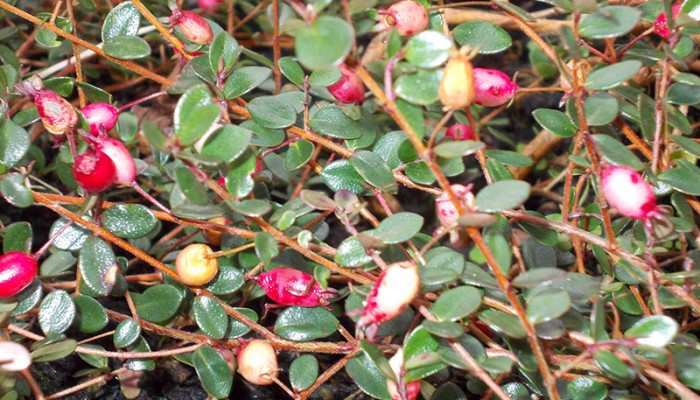The delightful Myrteola nummularia is a hardy evergreen, prostrate shrub forming a thick mat typically only about 10cm high. Native of The Andes of southern Chile, south-west Argentina, Tierra del Fuego and the Falkland Islands, it is often associated with Empetrum rubrum, Gaultheria mucronata and Blechnum penna-marina.
The hardiest member of the Myrteaceae, it was first collected by the French naturalist Dr. Philibert Commerçon, who accompanied Louis Antoine de Bougainville on his voyage of circumnavigation between 1766 and 1769. Whenever he had the opportunity he collected plants in large quantities. It is thought he collected some 3,000 species new to science and it was Commerçon who named Bougainvillea after the captain. While on Tahiti it was discovered that his ‘servant’ was his housekeeper and lover Jeanne Barret dressed as a man. Although women were strictly forbidden on French Navy ships at the time the event was a source amusement rather than scorn. Of ill-health, Commerçon left the expedition in December 1768, staying on Ile de Bourbon (now the island of Réunion). He died on the island in 1773 and his manuscripts and herbaria were taken to Paris after his death. The prostrate myrtle was described and named as Myrtus nummularia in 1796. It was again collected from Tierra del Fuego by Charles Darwin in 1833 during his voyage on the Beagle. It was moved into the new genus of Myrteola in 1856. There had been a number of subsequent collections but was not introduced in to cultivation until 1927 and has never become established in gardens, although it was awarded the RHS Award of Merit in 1967.
In cultivation Myrteola nummularia is well suited to the rock garden or to soften the edges of areas of gravel. The red-tinged wiry stems carry small, glossy-green, rounded leaves in paired ranks. The flowers are small, white with four or occasionally five rounded petals. Flowering usually commences in April and continues in to July or August, but a small number of flowers are nearly always present. These are followed by small pinky-red berries which are long-lasting, the net effect is that there are always flowers or fruits present on the plants, and for the greater part of the year, both.

